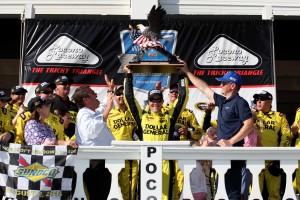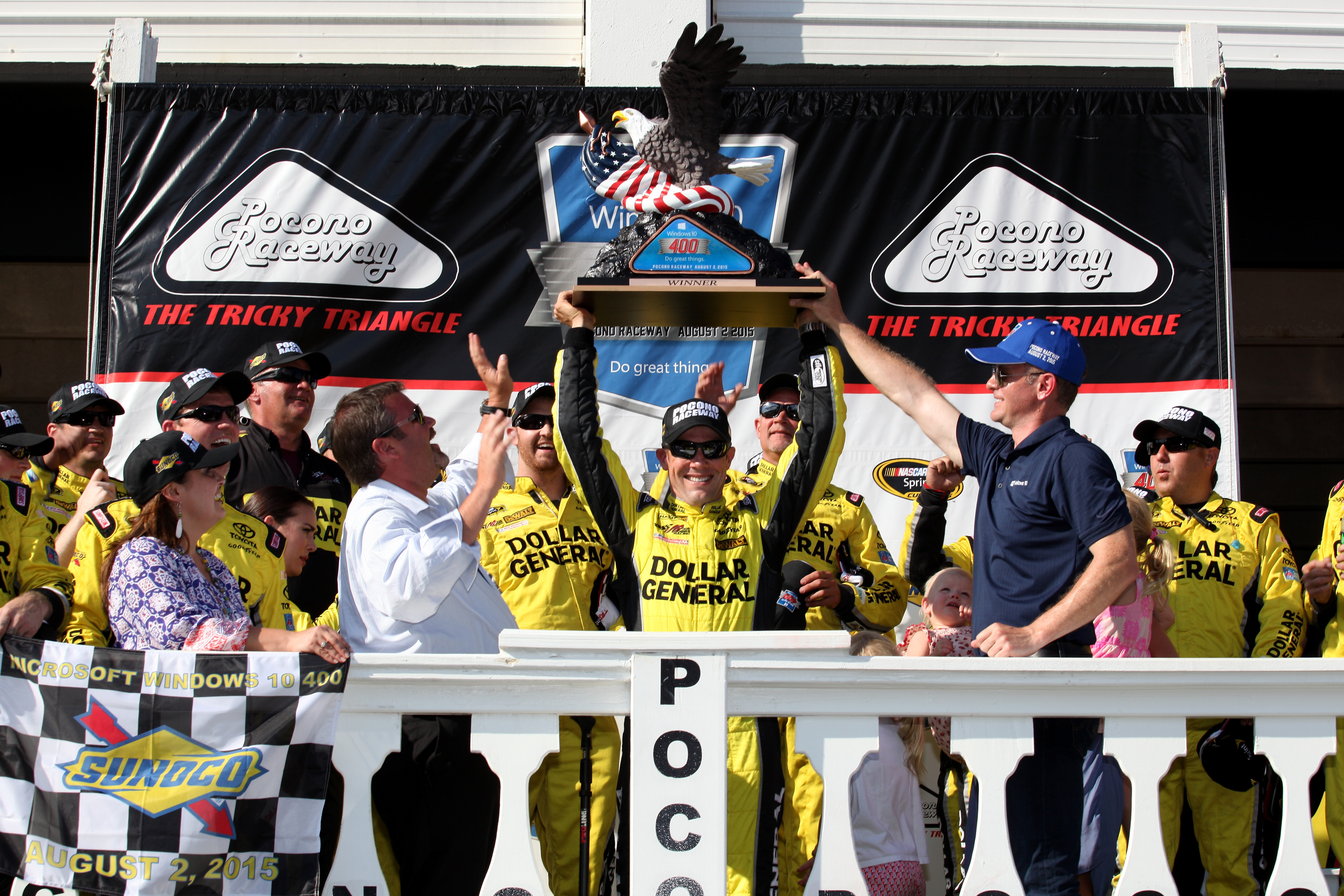
In today’s world, the car industry is all about one thing, performance without sacrificing fuel mileage. Let’s face it, every driver is concerned about this as even though the cost of a gallon of gas has dropped a dollar since this time a year ago, it’s still on the higher end of the spectrum as far as cost of living.
We all worry about whether we have enough gas in the tank to get somewhere, or how much it will cost to fill up, and how long it will last.
And let’s face it, every one of us has been in that predicament where we are very close on gas, trying to make it to the station, and want to stretch it that little extra bit so that right when we pull into the pump, there’s still enough to keep the engine running.
Pushing the limits of fuel isn’t uncommon in NASCAR either. Fuel mileage races are an occurrence where the crew chief goes from being the one calling the changes in setup to doing the math for the fuel in the tank.
Sunday at Pocono, a track that has seen it’s fair share of fuel mileage races in it’s time, saw another one that cost two drivers a strong finish, and handed another his second win of the season. Both Joey Logano and Kyle Busch each were trying their hardest to stretch their tank to make it to the end. Logano was leading until halfway through lap 158, when his car sputtered on the Long Pond straightaway.
Shortly after Busch took the white flag, even though he was told to save, he ran dry. He never made it back to the finish line, and actually had a push to get across to finish the race, a move that was illegal and relegated him to the final car on the lead lap (which even if he didn’t cross the line he would’ve been credited with anyway).
So how exactly are these drivers saving fuel?
Back when the cars ran carburetors, it was a bit easier. Drivers could lift off the gas entering the corner, but still had fuel in the carbs to keep the engine running. There were also some that would push the clutch in to cut the engine off, coasting around the corners. When it was time to get back on the accelerator, the clutch was released and the engine restarted.
Then there’s the way to save without even shutting the engine off, and that’s using the draft. The car in front has to stay on the gas harder, as it’s making the hole in the air for the second car. The one directly behind can go just as fast, but keep power in reserve, reducing the amount of fuel being used.
With today’s electronic fuel injection systems, it’s a bit more complicated. Sure, the engine can be cut off, but it’s not as easy as just flipping a switch anymore to continue on. The EFI as it’s called, it gets reset, then the engine fires again. The clutch can still be used to cut power, but the driver needs to keep in mind to not push it and let the RPM’s go too high, cause the engine or transmission would let go, and that’s never a good deal.
But the easiest way is still letting off the gas early, and coasting through the corner, while slowly rolling into the throttle off the corner to keep fuel in the tank for the pump to retrieve.
Even as we ourselves try to conserve gas, it’s the same deal. Drivers will put their vehicle in neutral, coast down a hill or around a corner, even doing so with the engine shut off, which also cuts the power steering but that’s a different topic. In a manual transmission, drivers keep it in the high gear and slowly roll into the gas since the RPM’s are so low.
Whether it’s trying to make it to the checkered flag, or just trying to make it to the local Sunoco station, fuel mileage is part of life. The biggest difference, if we run out of fuel, at the very least we can call someone to either put a few gallons in the tank or push the staved car or truck out of the way so it’s not blocking traffic. In NASCAR, the fuel man can’t run out on the track to do a “splash and go.” If a car runs dry, with the exception of the final lap, they will get a push to the pits, but end up losing time, laps, and possibly a victory.
Fuel mileage, always a factor, whether it’s buying a car, or getting one to victory lane.
RESULTS: 1-Kenseth 2-Keselowski 3-Gordon 4-Earnhardt Jr. 5-Biffle 6-Johnson 7-Allmendinger 8-Bowyer 9-Stewart 10-Edwards
NOTABLE FINISHES: 19-Truex Jr. 20-Logano 21-Kyle Busch 22-Hamlin 37-Kurt Busch 42-Harvick
CAUTIONS: 8 for 32 laps. Laps: 6-9 (#5 accident-FS [Red Flag: Lap 7, 14 Mins, 43 Secs.]); 17-19 (Competition); 21-23 (Oil on track from #4); 29-33 (#9,
17 accident turn 1 [98]); 62-65 (Debris on pit road [98]); 67-71 (#9, 27, 41 accident turn 1 [2]); 73-75 (#35, 88 accident-T1); 93-97 (#33 accident-T1).
LEAD CHANGES: Kyle Busch 1-16; Harvick 17-19; Kurt Busch 20-32; Truex Jr. 33-38; Logano 39-51; Kyle Busch 52; Hamlin 53-54; Keselowski 55-57; Patrick 58-62; Logano 63-87; Kenseth 88; Larson 89-93; Logano 94-123; Ragan 124; Biffle 125-126; Gordon 127-128; Logano 129-157; Kyle Busch 158-159; Kenseth 160.
TIME OF RACE: 3 Hrs, 1 Min, 36 Secs.
AVERAGE SPEED: 132.159 MPH
MARGIN OF VICTORY: 9.012 Seconds
CHASE GRID: 1. Johnson-713 (Points), 4 (wins); 2. Harvick-780, 2; 3. Earnhardt Jr-717, 2 wins; 4. Kenseth-622, 2; 5. Kurt Busch-620, 2; 6. Logano-734, 1; 7. Truex Jr-694, 1; 8. Keselowski-681, 1; 9. Hamlin-614, 1; 10. Edwards-553, 11. McMurray, -149 (from 1st); 12. Gordon, -163; 13. Menard, -189; 14. Newman, -196; 15. Bowyer, -206; 16. Kahne, -221.




